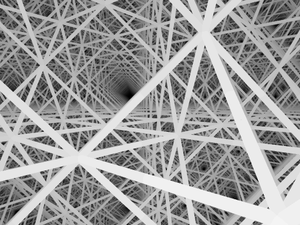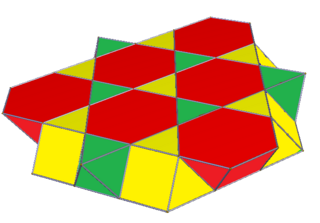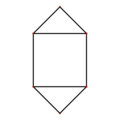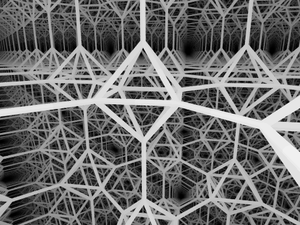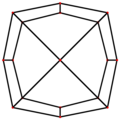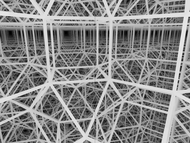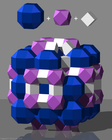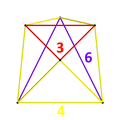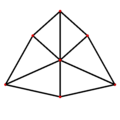Cubic honeycomb
| Cubic honeycomb | |
|---|---|
  | |
| Type | Regular honeycomb |
| Family | Hypercube honeycomb |
| Indexing[1] | J11,15, A1 W1, G22 |
| Schläfli symbol | {4,3,4} |
| Coxeter diagram | |
| Cell type | {4,3} |
| Face type | square {4} |
| Vertex figure |  octahedron |
| Space group Fibrifold notation | Pm3m (221) 4−:2 |
| Coxeter group | , [4,3,4] |
| Dual | self-dual Cell:  |
| Properties | Vertex-transitive, regular |
The cubic honeycomb or cubic cellulation is the only proper regular space-filling tessellation (or honeycomb) in Euclidean 3-space made up of cubic cells. It has 4 cubes around every edge, and 8 cubes around each vertex. Its vertex figure is a regular octahedron. It is a self-dual tessellation with Schläfli symbol {4,3,4}. John Horton Conway called this honeycomb a cubille.
A geometric honeycomb is a space-filling of polyhedral or higher-dimensional cells, so that there are no gaps. It is an example of the more general mathematical tiling or tessellation in any number of dimensions.
Honeycombs are usually constructed in ordinary Euclidean ("flat") space, like the convex uniform honeycombs. They may also be constructed in non-Euclidean spaces, such as hyperbolic uniform honeycombs. Any finite uniform polytope can be projected to its circumsphere to form a uniform honeycomb in spherical space.
Related honeycombs[edit]
It is part of a multidimensional family of hypercube honeycombs, with Schläfli symbols of the form {4,3,...,3,4}, starting with the square tiling, {4,4} in the plane.
It is one of 28 uniform honeycombs using convex uniform polyhedral cells.
Isometries of simple cubic lattices[edit]
Simple cubic lattices can be distorted into lower symmetries, represented by lower crystal systems:
| Crystal system | Monoclinic Triclinic | Orthorhombic | Tetragonal | Rhombohedral | Cubic |
|---|---|---|---|---|---|
| Unit cell | Parallelepiped | Rectangular cuboid | Square cuboid | Trigonal trapezohedron | Cube |
| Point group Order Rotation subgroup | [ ], (*) Order 2 [ ]+, (1) | [2,2], (*222) Order 8 [2,2]+, (222) | [4,2], (*422) Order 16 [4,2]+, (422) | [3], (*33) Order 6 [3]+, (33) | [4,3], (*432) Order 48 [4,3]+, (432) |
| Diagram |  |  |  |  |  |
| Space group Rotation subgroup | Pm (6) P1 (1) | Pmmm (47) P222 (16) | P4/mmm (123) P422 (89) | R3m (160) R3 (146) | Pm3m (221) P432 (207) |
| Coxeter notation | - | [∞]a×[∞]b×[∞]c | [4,4]a×[∞]c | - | [4,3,4]a |
| Coxeter diagram | - | - |
Uniform colorings[edit]
There is a large number of uniform colorings, derived from different symmetries. These include:
| Coxeter notation Space group | Coxeter diagram | Schläfli symbol | Partial honeycomb | Colors by letters |
|---|---|---|---|---|
| [4,3,4] Pm3m (221) | {4,3,4} |  | 1: aaaa/aaaa | |
| [4,31,1] = [4,3,4,1+] Fm3m (225) | {4,31,1} | 2: abba/baab | ||
| [4,3,4] Pm3m (221) | t0,3{4,3,4} |  | 4: abbc/bccd | |
| [[4,3,4]] Pm3m (229) | t0,3{4,3,4} | 4: abbb/bbba | ||
| [4,3,4,2,∞] | or | {4,4}×t{∞} | 2: aaaa/bbbb | |
| [4,3,4,2,∞] | t1{4,4}×{∞} | 2: abba/abba | ||
| [∞,2,∞,2,∞] | t{∞}×t{∞}×{∞} | 4: abcd/abcd | ||
| [∞,2,∞,2,∞] = [4,(3,4)*] | t{∞}×t{∞}×t{∞} | 8: abcd/efgh |
Projections[edit]
The cubic honeycomb can be orthogonally projected into the euclidean plane with various symmetry arrangements. The highest (hexagonal) symmetry form projects into a triangular tiling. A square symmetry projection forms a square tiling.
| Symmetry | p6m (*632) | p4m (*442) | pmm (*2222) | ||
|---|---|---|---|---|---|
| Solid |  |  |  | ||
| Frame |  | 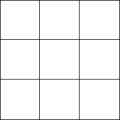 |  | ||
Related polytopes and honeycombs[edit]
It is related to the regular 4-polytope tesseract, Schläfli symbol {4,3,3}, which exists in 4-space, and only has 3 cubes around each edge. It's also related to the order-5 cubic honeycomb, Schläfli symbol {4,3,5}, of hyperbolic space with 5 cubes around each edge.
It is in a sequence of polychora and honeycombs with octahedral vertex figures.
| {p,3,4} regular honeycombs | |||||||||||
|---|---|---|---|---|---|---|---|---|---|---|---|
| Space | S3 | E3 | H3 | ||||||||
| Form | Finite | Affine | Compact | Paracompact | Noncompact | ||||||
| Name | {3,3,4} | {4,3,4} | {5,3,4} | {6,3,4} | {7,3,4} | {8,3,4} | ... {∞,3,4} | ||||
| Image |  |  |  |  |  |  |  | ||||
| Cells | {3,3} | {4,3} | {5,3} | {6,3} | {7,3} | {8,3} | {∞,3} | ||||
It in a sequence of regular polytopes and honeycombs with cubic cells.
| {4,3,p} regular honeycombs | |||||||||||
|---|---|---|---|---|---|---|---|---|---|---|---|
| Space | S3 | E3 | H3 | ||||||||
| Form | Finite | Affine | Compact | Paracompact | Noncompact | ||||||
| Name | {4,3,3} | {4,3,4} | {4,3,5} | {4,3,6} | {4,3,7} | {4,3,8} | ... {4,3,∞} | ||||
| Image |  |  |  |  |  |  |  | ||||
| Vertex figure |  {3,3} |  {3,4} |  {3,5} |  {3,6} |  {3,7} |  {3,8} |  {3,∞} | ||||
| {p,3,p} regular honeycombs | |||||||||||
|---|---|---|---|---|---|---|---|---|---|---|---|
| Space | S3 | Euclidean E3 | H3 | ||||||||
| Form | Finite | Affine | Compact | Paracompact | Noncompact | ||||||
| Name | {3,3,3} | {4,3,4} | {5,3,5} | {6,3,6} | {7,3,7} | {8,3,8} | ...{∞,3,∞} | ||||
| Image |  |  |  |  |  |  |  | ||||
| Cells |  {3,3} |  {4,3} |  {5,3} |  {6,3} |  {7,3} |  {8,3} |  {∞,3} | ||||
| Vertex figure |  {3,3} |  {3,4} |  {3,5} |  {3,6} |  {3,7} |  {3,8} |  {3,∞} | ||||
Related polytopes[edit]
The cubic honeycomb has a lower symmetry as a runcinated cubic honeycomb, with two sizes of cubes. A double symmetry construction can be constructed by placing a small cube into each large cube, resulting in a nonuniform honeycomb with cubes, square prisms, and rectangular trapezoprisms (a cube with D2d symmetry). Its vertex figure is a triangular pyramid with its lateral faces augmented by tetrahedra.
The resulting honeycomb can be alternated to produce another nonuniform honeycomb with regular tetrahedra, two kinds of tetragonal disphenoids, triangular pyramids, and sphenoids. Its vertex figure has C3v symmetry and has 26 triangular faces, 39 edges, and 15 vertices.
Related Euclidean tessellations[edit]
The [4,3,4], ![]()
![]()
![]()
![]()
![]()
![]()
![]() , Coxeter group generates 15 permutations of uniform tessellations, 9 with distinct geometry including the alternated cubic honeycomb. The expanded cubic honeycomb (also known as the runcinated cubic honeycomb) is geometrically identical to the cubic honeycomb.
, Coxeter group generates 15 permutations of uniform tessellations, 9 with distinct geometry including the alternated cubic honeycomb. The expanded cubic honeycomb (also known as the runcinated cubic honeycomb) is geometrically identical to the cubic honeycomb.
| C3 honeycombs | |||||
|---|---|---|---|---|---|
| Space group | Fibrifold | Extended symmetry | Extended diagram | Order | Honeycombs |
| Pm3m (221) | 4−:2 | [4,3,4] | ×1 | ||
| Fm3m (225) | 2−:2 | [1+,4,3,4] ↔ [4,31,1] | ↔ | Half | |
| I43m (217) | 4o:2 | [[(4,3,4,2+)]] | Half × 2 | ||
| Fd3m (227) | 2+:2 | [[1+,4,3,4,1+]] ↔ [[3[4]]] | ↔ | Quarter × 2 | |
| Im3m (229) | 8o:2 | [[4,3,4]] | ×2 | ||
The [4,31,1], ![]()
![]()
![]()
![]()
![]() , Coxeter group generates 9 permutations of uniform tessellations, 4 with distinct geometry including the alternated cubic honeycomb.
, Coxeter group generates 9 permutations of uniform tessellations, 4 with distinct geometry including the alternated cubic honeycomb.
| B3 honeycombs | |||||
|---|---|---|---|---|---|
| Space group | Fibrifold | Extended symmetry | Extended diagram | Order | Honeycombs |
| Fm3m (225) | 2−:2 | [4,31,1] ↔ [4,3,4,1+] | ↔ | ×1 | |
| Fm3m (225) | 2−:2 | <[1+,4,31,1]> ↔ <[3[4]]> | ↔ | ×2 | |
| Pm3m (221) | 4−:2 | <[4,31,1]> | ×2 | ||
This honeycomb is one of five distinct uniform honeycombs[2] constructed by the Coxeter group. The symmetry can be multiplied by the symmetry of rings in the Coxeter–Dynkin diagrams:
| A3 honeycombs | ||||||
|---|---|---|---|---|---|---|
| Space group | Fibrifold | Square symmetry | Extended symmetry | Extended diagram | Extended group | Honeycomb diagrams |
| F43m (216) | 1o:2 | a1 | [3[4]] | (None) | ||
| Fm3m (225) | 2−:2 | d2 | <[3[4]]> ↔ [4,31,1] | ↔ | ×21 ↔ | |
| Fd3m (227) | 2+:2 | g2 | [[3[4]]] or [2+[3[4]]] | ↔ | ×22 | |
| Pm3m (221) | 4−:2 | d4 | <2[3[4]]> ↔ [4,3,4] | ↔ | ×41 ↔ | |
| I3 (204) | 8−o | r8 | [4[3[4]]]+ ↔ [[4,3+,4]] | ↔ | ½×8 ↔ ½×2 | |
| Im3m (229) | 8o:2 | [4[3[4]]] ↔ [[4,3,4]] | ×8 ↔ ×2 | |||
Rectified cubic honeycomb[edit]
| Rectified cubic honeycomb | |
|---|---|
| Type | Uniform honeycomb |
| Schläfli symbol | r{4,3,4} or t1{4,3,4} r{4,31,1} 2r{4,31,1} r{3[4]} |
| Coxeter diagrams | |
| Cells | r{4,3} {3,4} |
| Faces | triangle {3} square {4} |
| Vertex figure |  square prism |
| Space group Fibrifold notation | Pm3m (221) 4−:2 |
| Coxeter group | , [4,3,4] |
| Dual | oblate octahedrille Cell:  |
| Properties | Vertex-transitive, edge-transitive |
The rectified cubic honeycomb or rectified cubic cellulation is a uniform space-filling tessellation (or honeycomb) in Euclidean 3-space. It is composed of octahedra and cuboctahedra in a ratio of 1:1, with a square prism vertex figure.
John Horton Conway calls this honeycomb a cuboctahedrille, and its dual an oblate octahedrille.
Projections[edit]
The rectified cubic honeycomb can be orthogonally projected into the euclidean plane with various symmetry arrangements.
| Symmetry | p6m (*632) | p4m (*442) | pmm (*2222) | ||
|---|---|---|---|---|---|
| Solid |  |  |  | ||
| Frame | 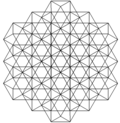 | 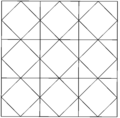 |  | ||
Symmetry[edit]
There are four uniform colorings for the cells of this honeycomb with reflective symmetry, listed by their Coxeter group, and Wythoff construction name, and the Coxeter diagram below.
| Symmetry | [4,3,4] | [1+,4,3,4] [4,31,1], | [4,3,4,1+] [4,31,1], | [1+,4,3,4,1+] [3[4]], |
|---|---|---|---|---|
| Space group | Pm3m (221) | Fm3m (225) | Fm3m (225) | F43m (216) |
| Coloring |  |  |  |  |
| Coxeter diagram | ||||
| Vertex figure |  |  |  |  |
| Vertex figure symmetry | D4h [4,2] (*224) order 16 | D2h [2,2] (*222) order 8 | C4v [4] (*44) order 8 | C2v [2] (*22) order 4 |
This honeycomb can be divided on trihexagonal tiling planes, using the hexagon centers of the cuboctahedra, creating two triangular cupolae. This scaliform honeycomb is represented by Coxeter diagram ![]()
![]()
![]()
![]()
![]()
![]()
![]() , and symbol s3{2,6,3}, with coxeter notation symmetry [2+,6,3].
, and symbol s3{2,6,3}, with coxeter notation symmetry [2+,6,3].
Related polytopes[edit]
A double symmetry construction can be made by placing octahedra on the cuboctahedra, resulting in a nonuniform honeycomb with two kinds of octahedra (regular octahedra and triangular antiprisms). The vertex figure is a square bifrustum. The dual is composed of elongated square bipyramids.
Truncated cubic honeycomb[edit]
| Truncated cubic honeycomb | |
|---|---|
| Type | Uniform honeycomb |
| Schläfli symbol | t{4,3,4} or t0,1{4,3,4} t{4,31,1} |
| Coxeter diagrams | |
| Cell type | t{4,3} {3,4} |
| Face type | triangle {3} octagon {8} |
| Vertex figure |  isosceles square pyramid |
| Space group Fibrifold notation | Pm3m (221) 4−:2 |
| Coxeter group | , [4,3,4] |
| Dual | Pyramidille Cell:  |
| Properties | Vertex-transitive |
The truncated cubic honeycomb or truncated cubic cellulation is a uniform space-filling tessellation (or honeycomb) in Euclidean 3-space. It is composed of truncated cubes and octahedra in a ratio of 1:1, with an isosceles square pyramid vertex figure.
John Horton Conway calls this honeycomb a truncated cubille, and its dual pyramidille.
Projections[edit]
The truncated cubic honeycomb can be orthogonally projected into the euclidean plane with various symmetry arrangements.
| Symmetry | p6m (*632) | p4m (*442) | pmm (*2222) | ||
|---|---|---|---|---|---|
| Solid |  |  |  | ||
| Frame |  | 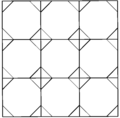 | 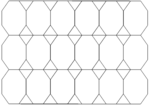 | ||
Symmetry[edit]
There is a second uniform coloring by reflectional symmetry of the Coxeter groups, the second seen with alternately colored truncated cubic cells.
| Construction | Bicantellated alternate cubic | Truncated cubic honeycomb |
|---|---|---|
| Coxeter group | [4,31,1], | [4,3,4], =<[4,31,1]> |
| Space group | Fm3m | Pm3m |
| Coloring |  |  |
| Coxeter diagram | ||
| Vertex figure |  |  |
Related polytopes[edit]
A double symmetry construction can be made by placing octahedra on the truncated cubes, resulting in a nonuniform honeycomb with two kinds of octahedra (regular octahedra and triangular antiprisms) and two kinds of tetrahedra (tetragonal disphenoids and digonal disphenoids). The vertex figure is an octakis square cupola.
Bitruncated cubic honeycomb[edit]
| Bitruncated cubic honeycomb | |
|---|---|
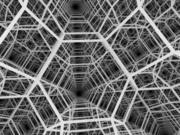 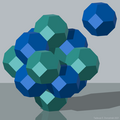 | |
| Type | Uniform honeycomb |
| Schläfli symbol | 2t{4,3,4} t1,2{4,3,4} |
| Coxeter-Dynkin diagram | |
| Cells | t{3,4} |
| Faces | square {4} hexagon {6} |
| Edge figure | isosceles triangle {3} |
| Vertex figure |  tetragonal disphenoid |
| Symmetry group Fibrifold notation Coxeter notation | Im3m (229) 8o:2 [[4,3,4]] |
| Coxeter group | , [4,3,4] |
| Dual | Oblate tetrahedrille Disphenoid tetrahedral honeycomb Cell:  |
| Properties | Vertex-transitive, edge-transitive, cell-transitive |

The bitruncated cubic honeycomb is a space-filling tessellation (or honeycomb) in Euclidean 3-space made up of truncated octahedra (or, equivalently, bitruncated cubes). It has four truncated octahedra around each vertex, in a tetragonal disphenoid vertex figure. Being composed entirely of truncated octahedra, it is cell-transitive. It is also edge-transitive, with 2 hexagons and one square on each edge, and vertex-transitive. It is one of 28 uniform honeycombs.
John Horton Conway calls this honeycomb a truncated octahedrille in his Architectonic and catoptric tessellation list, with its dual called an oblate tetrahedrille, also called a disphenoid tetrahedral honeycomb. Although a regular tetrahedron can not tessellate space alone, this dual has identical disphenoid tetrahedron cells with isosceles triangle faces.
Projections[edit]
The bitruncated cubic honeycomb can be orthogonally projected into the euclidean plane with various symmetry arrangements. The highest (hexagonal) symmetry form projects into a nonuniform rhombitrihexagonal tiling. A square symmetry projection forms two overlapping truncated square tiling, which combine together as a chamfered square tiling.
| Symmetry | p6m (*632) | p4m (*442) | pmm (*2222) | ||
|---|---|---|---|---|---|
| Solid |  | 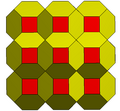 |  | 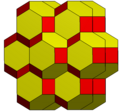 |  |
| Frame |  | 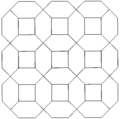 |  |  | 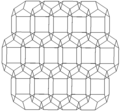 |
Symmetry[edit]
The vertex figure for this honeycomb is a disphenoid tetrahedron, and it is also the Goursat tetrahedron (fundamental domain) for the Coxeter group. This honeycomb has four uniform constructions, with the truncated octahedral cells having different Coxeter groups and Wythoff constructions. These uniform symmetries can be represented by coloring differently the cells in each construction.
| Space group | Im3m (229) | Pm3m (221) | Fm3m (225) | F43m (216) | Fd3m (227) |
|---|---|---|---|---|---|
| Fibrifold | 8o:2 | 4−:2 | 2−:2 | 1o:2 | 2+:2 |
| Coxeter group | ×2 [[4,3,4]] =[4[3[4]]] | [4,3,4] =[2[3[4]]] | [4,31,1] =<[3[4]]> | [3[4]] | ×2 [[3[4]]] =[[3[4]]] |
| Coxeter diagram | |||||
| truncated octahedra | 1 | 1:1 | 2:1:1 | 1:1:1:1 | 1:1 |
| Vertex figure |  |  |  |  |  |
| Vertex figure symmetry | [2+,4] (order 8) | [2] (order 4) | [ ] (order 2) | [ ]+ (order 1) | [2]+ (order 2) |
| Image Colored by cell |  |  |  |  |  |
Related polytopes[edit]
Nonuniform variants with [4,3,4] symmetry and two types of truncated octahedra can be doubled by placing the two types of truncated octahedra to produce a nonuniform honeycomb with truncated octahedra and hexagonal prisms (as ditrigonal trapezoprisms). Its vertex figure is a C2v-symmetric triangular bipyramid.
This honeycomb can then be alternated to produce another nonuniform honeycomb with pyritohedral icosahedra, octahedra (as triangular antiprisms), and tetrahedra (as sphenoids). Its vertex figure has C2v symmetry and consists of 2 pentagons, 4 rectangles, 4 isosceles triangles (divided into two sets of 2), and 4 scalene triangles.
Alternated bitruncated cubic honeycomb[edit]
| Alternated bitruncated cubic honeycomb | |
|---|---|
| Type | Convex honeycomb |
| Schläfli symbol | 2s{4,3,4} 2s{4,31,1} sr{3[4]} |
| Coxeter diagrams | |
| Cells | {3,3} s{3,3} |
| Faces | triangle {3} |
| Vertex figure |  |
| Coxeter group | [[4,3+,4]], |
| Dual | Ten-of-diamonds honeycomb Cell:  |
| Properties | Vertex-transitive, non-uniform |
The alternated bitruncated cubic honeycomb or bisnub cubic honeycomb is non-uniform, with the highest symmetry construction reflecting an alternation of the uniform bitruncated cubic honeycomb. A lower-symmetry construction involves regular icosahedra paired with golden icosahedra (with 8 equilateral triangles paired with 12 golden triangles). There are three constructions from three related Coxeter diagrams: ![]()
![]()
![]()
![]()
![]()
![]()
![]() ,
, ![]()
![]()
![]()
![]()
![]() , and
, and ![]()
![]()
![]()
![]()
![]() . These have symmetry [4,3+,4], [4,(31,1)+] and [3[4]]+ respectively. The first and last symmetry can be doubled as [[4,3+,4]] and [[3[4]]]+.
. These have symmetry [4,3+,4], [4,(31,1)+] and [3[4]]+ respectively. The first and last symmetry can be doubled as [[4,3+,4]] and [[3[4]]]+.
This honeycomb is represented in the boron atoms of the α-rhombohedral crystal. The centers of the icosahedra are located at the fcc positions of the lattice.[3]
| Space group | I3 (204) | Pm3 (200) | Fm3 (202) | Fd3 (203) | F23 (196) |
|---|---|---|---|---|---|
| Fibrifold | 8−o | 4− | 2− | 2o+ | 1o |
| Coxeter group | [[4,3+,4]] | [4,3+,4] | [4,(31,1)+] | [[3[4]]]+ | [3[4]]+ |
| Coxeter diagram | |||||
| Order | double | full | half | quarter double | quarter |
Cantellated cubic honeycomb[edit]
| Cantellated cubic honeycomb | |
|---|---|
| Type | Uniform honeycomb |
| Schläfli symbol | rr{4,3,4} or t0,2{4,3,4} rr{4,31,1} |
| Coxeter diagram | |
| Cells | rr{4,3} r{4,3} {}x{4} |
| Vertex figure |  wedge |
| Space group Fibrifold notation | Pm3m (221) 4−:2 |
| Coxeter group | [4,3,4], |
| Dual | quarter oblate octahedrille Cell:  |
| Properties | Vertex-transitive |
The cantellated cubic honeycomb or cantellated cubic cellulation is a uniform space-filling tessellation (or honeycomb) in Euclidean 3-space. It is composed of rhombicuboctahedra, cuboctahedra, and cubes in a ratio of 1:1:3, with a wedge vertex figure.
John Horton Conway calls this honeycomb a 2-RCO-trille, and its dual quarter oblate octahedrille.
Images[edit]
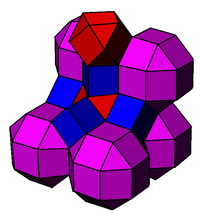 | 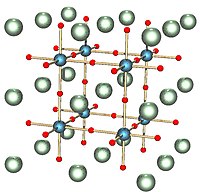 It is closely related to the perovskite structure, shown here with cubic symmetry, with atoms placed at the center of the cells of this honeycomb. |
Projections[edit]
The cantellated cubic honeycomb can be orthogonally projected into the euclidean plane with various symmetry arrangements.
| Symmetry | p6m (*632) | p4m (*442) | pmm (*2222) | ||
|---|---|---|---|---|---|
| Solid |  | 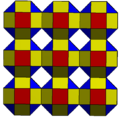 | 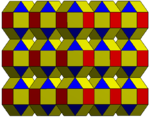 | ||
| Frame |  | 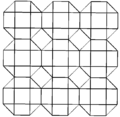 | 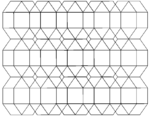 | ||
Symmetry[edit]
There is a second uniform colorings by reflectional symmetry of the Coxeter groups, the second seen with alternately colored rhombicuboctahedral cells.
| Construction | Truncated cubic honeycomb | Bicantellated alternate cubic |
|---|---|---|
| Coxeter group | [4,3,4], =<[4,31,1]> | [4,31,1], |
| Space group | Pm3m | Fm3m |
| Coxeter diagram | ||
| Coloring | 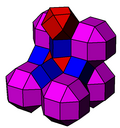 | 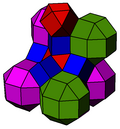 |
| Vertex figure | 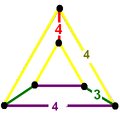 | 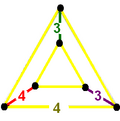 |
| Vertex figure symmetry | [ ] order 2 | [ ]+ order 1 |
Related polytopes[edit]
A double symmetry construction can be made by placing cuboctahedra on the rhombicuboctahedra, which results in the rectified cubic honeycomb, by taking the triangular antiprism gaps as regular octahedra, square antiprism pairs and zero-height tetragonal disphenoids as components of the cuboctahedron. Other variants result in cuboctahedra, square antiprisms, octahedra (as triangular antipodiums), and tetrahedra (as tetragonal disphenoids), with a vertex figure topologically equivalent to a cube with a triangular prism attached to one of its square faces.
Quarter oblate octahedrille[edit]
The dual of the cantellated cubic honeycomb is called a quarter oblate octahedrille, a catoptric tessellation with Coxeter diagram ![]()
![]()
![]()
![]()
![]()
![]()
![]() , containing faces from two of four hyperplanes of the cubic [4,3,4] fundamental domain.
, containing faces from two of four hyperplanes of the cubic [4,3,4] fundamental domain.
It has irregular triangle bipyramid cells which can be seen as 1/12 of a cube, made from the cube center, 2 face centers, and 2 vertices.
Cantitruncated cubic honeycomb[edit]
| Cantitruncated cubic honeycomb | |
|---|---|
| Type | Uniform honeycomb |
| Schläfli symbol | tr{4,3,4} or t0,1,2{4,3,4} tr{4,31,1} |
| Coxeter diagram | |
| Cells | tr{4,3} t{3,4} {}x{4} |
| Faces | square {4} hexagon {6} octagon {8} |
| Vertex figure |   mirrored sphenoid |
| Coxeter group | [4,3,4], |
| Symmetry group Fibrifold notation | Pm3m (221) 4−:2 |
| Dual | triangular pyramidille Cells:  |
| Properties | Vertex-transitive |
The cantitruncated cubic honeycomb or cantitruncated cubic cellulation is a uniform space-filling tessellation (or honeycomb) in Euclidean 3-space, made up of truncated cuboctahedra, truncated octahedra, and cubes in a ratio of 1:1:3, with a mirrored sphenoid vertex figure.
John Horton Conway calls this honeycomb a n-tCO-trille, and its dual triangular pyramidille.
Images[edit]
Four cells exist around each vertex:
Projections[edit]
The cantitruncated cubic honeycomb can be orthogonally projected into the euclidean plane with various symmetry arrangements.
| Symmetry | p6m (*632) | p4m (*442) | pmm (*2222) | ||
|---|---|---|---|---|---|
| Solid | 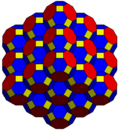 | 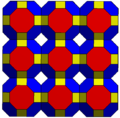 |  | ||
| Frame |  | 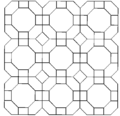 | 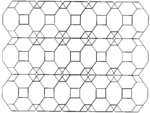 | ||
Symmetry[edit]
Cells can be shown in two different symmetries. The linear Coxeter diagram form can be drawn with one color for each cell type. The bifurcating diagram form can be drawn with two types (colors) of truncated cuboctahedron cells alternating.
| Construction | Cantitruncated cubic | Omnitruncated alternate cubic |
|---|---|---|
| Coxeter group | [4,3,4], =<[4,31,1]> | [4,31,1], |
| Space group | Pm3m (221) | Fm3m (225) |
| Fibrifold | 4−:2 | 2−:2 |
| Coloring |  |  |
| Coxeter diagram | ||
| Vertex figure |  |  |
| Vertex figure symmetry | [ ] order 2 | [ ]+ order 1 |
Triangular pyramidille[edit]
The dual of the cantitruncated cubic honeycomb is called a triangular pyramidille, with Coxeter diagram, ![]()
![]()
![]()
![]()
![]()
![]()
![]() . This honeycomb cells represents the fundamental domains of symmetry.
. This honeycomb cells represents the fundamental domains of symmetry.
A cell can be as 1/24 of a translational cube with vertices positioned: taking two corner, ne face center, and the cube center. The edge colors and labels specify how many cells exist around the edge.
Related polyhedra and honeycombs[edit]
It is related to a skew apeirohedron with vertex configuration 4.4.6.6, with the octagons and some of the squares removed. It can be seen as constructed by augmenting truncated cuboctahedral cells, or by augmenting alternated truncated octahedra and cubes.
 |  |
Related polytopes[edit]
A double symmetry construction can be made by placing truncated octahedra on the truncated cuboctahedra, resulting in a nonuniform honeycomb with truncated octahedra, hexagonal prisms (as ditrigonal trapezoprisms), cubes (as square prisms), triangular prisms (as C2v-symmetric wedges), and tetrahedra (as tetragonal disphenoids). Its vertex figure is topologically equivalent to the octahedron.
Alternated cantitruncated cubic honeycomb[edit]
| Alternated cantitruncated cubic honeycomb | |
|---|---|
| Type | Convex honeycomb |
| Schläfli symbol | sr{4,3,4} sr{4,31,1} |
| Coxeter diagrams | |
| Cells | s{4,3} s{3,3} {3,3} |
| Faces | triangle {3} square {4} |
| Vertex figure |   |
| Coxeter group | [(4,3)+,4] |
| Dual | Cell:  |
| Properties | Vertex-transitive, non-uniform |
The alternated cantitruncated cubic honeycomb or snub rectified cubic honeycomb contains three types of cells: snub cubes, icosahedra (with Th symmetry), tetrahedra (as tetragonal disphenoids), and new tetrahedral cells created at the gaps.
Although it is not uniform, constructionally it can be given as Coxeter diagrams ![]()
![]()
![]()
![]()
![]() or
or ![]()
![]()
![]()
![]()
![]()
![]()
![]() .
.
Despite being non-uniform, there is a near-miss version with two edge lengths shown below, one of which is around 4.3% greater than the other. The snub cubes in this case are uniform, but the rest of the cells are not.
 |


 French
French Deutsch
Deutsch



